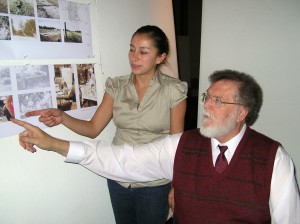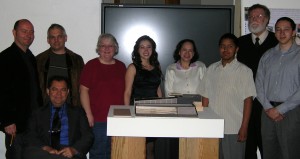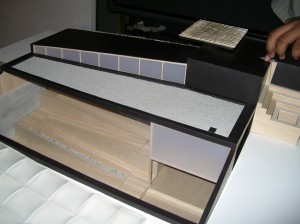Masters Projects
In addition to the UNL and University of Arizona studio programs focusing on Boone County, two UNL masters students, Jake Slobodnik and Yaravi Lopez-Wilson, used Boone County as the inspiration and/or location for their thesis work.
Yaravi
Yaravi Lopez-Wilson, who spent her early years living on her grandparents’ avocado farm in Mexico, focused on multi-generational living in conjunction with year-round small-scale vegetable production. Taking her inspiration from a successful subterranean greenhouse near Alliance, NE, Yaravi developed a semi-subterranean structure combining a greenhouse with a living space. Her design was compact enough to fit within an urban setting and energy efficient enough to make the year-round production of vegetables and even some fruits practical.
Yaravi selected an unused lot in downtown Albion for the location of her thesis project. Her design would be built partially into the earth and bermed on the north to block cold winter winds. It was glassed on the south so the greenhouse portion could use the sun not only to grow plants but to provide heat for the dwelling in the winter.
Yaravi’s design objective was to provide a low-cost source of fresh vegetables year round, for family use and for sharing with neighbors and sale to others. Her approach provided a way for those interested in food production to do so on a small scale, making it possible for people to enter or re-enter the field of agriculture without an enormous investment in land and machinery. Moreover, her design was intended to improve the health of people living in rural areas by providing a practical year-round means for of providing fresh produce, thereby reducing dependence on processed foods.
Her design was also planned to be as energy efficient as possible, utilizing the constant temperature of the ground for cooling in the summer and capturing the sun’s heat in the winter. Finally, it was designed to strengthen families by providing a safe, barrier-free environment to aid the mobility of both the elderly and the very young.
Project Board 1 Project Board 2 Renderings
Jake
Jake Slobodnik’s project sought to address the silent problem of rural homelessness. While in cities the homeless are fairly visible, the rural homeless generally are not. Rural homeless shelters do exist, but displaced people frequently seek temporary shelter with family and friends, sometimes even living from their cars while looking for employment. Those without homes are often single parent families; a particular problem in rural areas can be finding appropriate living spaces for women and children leaving abusive or violent environments.
In seeking new ways to shelter the rural homeless, Jake took his inspiration from modern grain elevators. Though originally made of wood, today these structures are made from continuously-poured concrete and rise many stories above the surrounding Plains. Jake devised award-winning ways to convert such structures into apartments, using a variety of techniques to provide interior lighting, including the use of a central column made of fiber optics to bring sunlight into the interior of these structures.
Abstract of Jake’s project:
Spring 5-8-2010
dwellevator (dwel-uh-vey-ter) -noun 1. a rehabilitative response to homelessness 2. the rehabilitation of derelict grain elevators
rehabilitate (ree-hu-bil-i-teyt) -verb 1. to restore to a condition of good health, ability to work, or the like.
It is estimated that there are over 3 million homeless individuals in the United States at any given time. Today’s homeless are far different than those of the past. History would have it that many of the past homeless were vagabonds looking to escape the rigid constraints of society, in search of a life with no rules, no restrictions, and most importantly, no responsibilities. The majority of today’s homeless are instead there, not my choice, but by circumstance. With the current economic decline, the United States is seeing an increase in homelessness and an increase in public costs associated with the epidemic. In 2008, it was estimated that the United States spent nearly $10.95 billion on indirect costs associated with homelessness including emergency care, crisis services, and incarcerations.
The very things currently considered to be assistance are the very things that sustain the lives of the homeless on the streets. Architects, politicians, educators and everyday citizens are challenged to think as sociologists and go beyond that of prolonging the situation through the distribution of food, clothing and rudimentary shelter and instead focus on the rehabilitation of the individual.
DWELLEVATOR is a graduate design thesis which explores the potential to aid the homeless – more specifically those homeless who are looking to better their lives – through the development of a rehabilitation program. This program, which is driven through architectural means, allows for the development of the individual through an understanding of responsibility and ownership of space.


